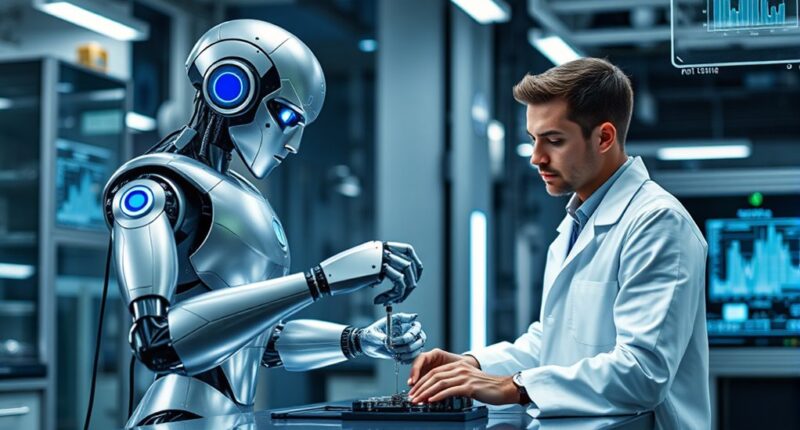Advanced robotics enhances workplace safety and efficiency by enabling seamless collaboration between humans and machines. Cobots are designed with safety features like smooth edges and compliant movements, making interactions safer and more ergonomic. These robots support tasks that are repetitive, heavy, or hazardous, reducing strain and fatigue. Continuous assessment guarantees safety protocols evolve, while engaging interfaces improve user experience. Staying aware of these innovations can help you better understand how future workplaces will become more collaborative and ergonomic.
Key Takeaways
- Ergonomic design in robotics enhances safety, comfort, and productivity through smooth interfaces and compliant movements.
- Collaborative robots (cobots) are equipped with safety features allowing close human interaction without barriers.
- Continuous assessment and updated safety protocols ensure secure and ergonomic human-robot work environments.
- Ergonomic integration reduces human fatigue and strain, enabling effective handling of repetitive or hazardous tasks.
- Engaging interface designs, including anime-inspired visuals, improve human-robot interaction and collaboration efficiency.

Equally vital is ergonomic integration, which focuses on designing workspaces and robot interfaces that support human comfort and productivity. When robots are ergonomically integrated into a work environment, they adapt to human needs rather than forcing humans to adapt to rigid systems. For instance, collaborative robots, or cobots, are built with safety features that allow them to operate in close proximity to humans without barriers. These robots are often designed with smooth, rounded edges and compliant movements that reduce the chance of injury. Additionally, their interfaces are user-friendly, enabling workers to program or adjust tasks easily without extensive training. This ergonomic approach guarantees that tasks are performed efficiently, reducing fatigue and strain, and ultimately improving overall workplace well-being. Incorporating anime-inspired designs in robot interfaces can also enhance user engagement and ease of use, fostering better human-robot interaction. Implementing effective robot safety measures and ergonomic integration involves continuous assessment and adaptation. You should regularly evaluate the workspace and update safety protocols to address emerging risks. Training workers on how to interact with robots safely is equally essential. When you foster a culture that values these principles, you create a collaborative environment where humans and robots complement each other’s strengths. Robots can handle repetitive, heavy, or hazardous tasks, freeing you to focus on more complex, strategic activities. Meanwhile, ergonomic integration ensures that the physical interaction remains comfortable and sustainable over long periods.
Frequently Asked Questions
How Do Robots Learn From Human Feedback in Collaborative Tasks?
You enable robots to learn from human feedback through machine learning, creating feedback loops that refine their actions. When you provide input or corrections, the robot updates its algorithms, improving performance over time. This process allows the robot to adapt to new tasks or environments, making collaboration more efficient. By continuously integrating your feedback, the robot becomes better at understanding and responding to your needs in collaborative tasks.
What Are the Ethical Considerations in Human-Robot Teamwork?
You should consider privacy concerns and accountability issues when working with robots. Guarantee personal data is protected and used ethically to prevent breaches. Clarify who’s responsible for robot actions, especially if errors occur, to avoid blame-shifting. By addressing these ethical concerns, you foster trust and safety in human-robot teamwork, making the collaboration more effective and responsible.
How Is Safety Ensured During Close Human-Robot Interactions?
Safety is secured through smart sensor integration and strict risk mitigation. You’ll find sensors that sense subtle shifts, stops, and signals, instantly reacting to human presence. This swift system prevents accidents, ensuring smooth, safe, and seamless collaboration. By constantly monitoring and managing risks, you confidently work close to robots, knowing safety measures are in place, providing protection and peace of mind in every shared space.
What Industries Are Most Impacted by Advanced Robotics Collaboration?
You’ll find that manufacturing automation and healthcare innovations are most impacted by advanced robotics collaboration. In manufacturing, robots streamline production, increase precision, and reduce labor costs. In healthcare, robots assist in surgeries, patient care, and diagnostics, improving outcomes and efficiency. These industries benefit greatly from human-robot teamwork, leading to safer, more effective processes. By integrating advanced robotics, you can expect increased productivity and enhanced service quality across these sectors.
How Do Robots Adapt to Unpredictable Human Behaviors?
Imagine you’re working alongside a robot in a warehouse, and it suddenly encounters an unexpected obstacle. You notice it quickly adjusts its path using sensor integration and adaptive algorithms, which allow it to interpret human gestures or sudden changes. These technologies enable robots to respond effectively to unpredictable human behaviors by constantly analyzing sensor data and adapting their actions in real-time, ensuring smoother, safer collaboration without needing pre-programmed responses for every scenario.
Conclusion
As you explore the future of robotics, remember that by 2030, over 20 million industrial robots will be working alongside humans worldwide. This collaboration isn’t just about automation; it’s about creating safer, more efficient workplaces where humans and robots share tasks seamlessly. Imagine a factory floor where robots assist with delicate assembly, reducing errors and injuries. Embracing this partnership transforms industries, making your role more innovative and impactful than ever before.








